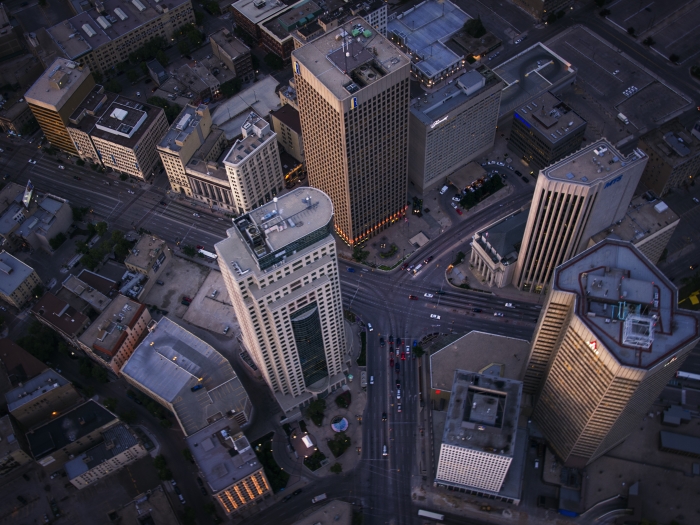Winnipeg is a shithole, but it’s a shithole with a certain je ne sais quoi. You’ve heard that before at dinner parties, on film and in song. Having a love/hate relationship with Winnipeg is the de facto position for those who make it home.

Now you can place a fabulous account of it on your coffee table with Stuck in the Middle: Dissenting Views of Winnipeg, the new book from photographer Bryan Scott and writer Bartley Kives.
Many will have seen Scott’s photography on his popular website www.winnipeglovehate.com, and his striking images will be what lure folks to the book. Scott’s photographs are vivid and painterly, and his stylistic hallmarks are consistent throughout.

He seeks out the odd, the interesting and the iconic for his compositions. The images are romanticized, certainly, but never quite so much as to stretch past the point of believability for those who have spent enough of their days and nights in this city. He saturates the Exchange District with deep reds, fills in shadows with their gritty details, and always seeks to include the full voltage of Manitoba sky.

Scott’s project is clearly to capture the magical austere quality of Winnipeg’s physical environment that makes up so much of the je ne sais quoi. He largely succeeds.

While some photography purists may whine about his use of HDR (an imaging technique used to capture a greater dynamic range between the lightest and darkest areas of an image by layering multiple exposure levels) most viewers will appreciate how Scott captures the way light strikes the high dynamic range of the continent.

My one quibble with the photography isn’t over style or technique, but content. There is too much Winnipeg love here and not enough hate. I love the love. The love should be here, but the hate needs much expanded coverage. There needs to be more of Winnipeg’s relentless ugliness to counterbalance the displays of hypnotic beauty. We need to see lots more road-salt caked to street corners in spring. There should also be more suburban monotony, more clinical depressiveness and more oppressive representations of winter weather systems. Much more like this photograph of skid marks in the snow next to a hideous fence protecting a hill that is literally a hill of garbage:

That said, people are going to pick up this book and flip through it looking at the pictures and love it. They’ll experience the enjoyment of recognition and relish the prompting that these images provide for their own recollections. They may discover a few spots that have remained hidden to them. Many will want to order prints of their favorites to hang in their homes. That’s great. But when they just flip through the pictures, they’re going to miss what makes this an essential Winnipeg document: Bartley Kives’ series of short essays.
Most Winnipeggers will be familiar with Kives from his regular gig as reporter-at-large for the Free Press. His contribution here immediately becomes the best Winnipeg primer available.
The book is broken up thematically into well conceived chapters such as “Architectural Wonders!”, “Bad Decisions”, “Things That Survived Our Best Efforts to Destroy Them” and “Things We Destroyed”. Each includes a great short essay from Kives and the relevant photo coverage from Scott.
Kives’ approach is one informed by his journalism, and so his pieces serve as a fantastic ‘Winnipeg: the story thus far’, from thaw of the glacier to the return of the Jets. Whether you know most of the story or barely any of it, Kives’ sober and balanced account of Winnipeg’s greatest hits and most tragic mistakes is essential reading. He allows himself a little more editorial comment than we get in his Free Press reporting, which makes for sharp assessments like this one:
“At the core of a Winnipegger’s belief system is the notion of a God-given freedom to drive wherever they want and park wherever they want – ideally right in front of wherever it is they’re going – with no charges or time limitations or any other rules upsetting the inviolable sanctity of their automobile’s right to pointlessly take up space.
Winnipeg is an automobile city, but not like Detroit or Oshawa, where they actually make the damn things. Winnipeggers love to drive because the size, scale and layout of the city forces them to do so. Beginning at a very early age, when young Winnipeggers learn about the inconveniences and indignities of public transit, they yearn to own and operate their own shiny little box of carbon-dioxide spewing metal that will forever consign themselves to a future of road rage, debt and obsessive gasoline-price watching.”
For more, check out this excerpt.
John K. Sampson gets it just right in his erudite forward when he calls Kives’ “a uniquely Winnipeg voice: caring and caustic, insightful and wry.” Of all the “My Winnipeg”s to date, Kives’ is perhaps the greatest. If nothing else, it is the most rigorously sane. My hope is that it is hauled off of dusty bookshelves to inform many future generations of Winnipeggers.
[related_content slugs=”lets-join-the-usa,night-on-the-towne,zero-dark-swayze,jets-flying-on-a-wing-and-our-prayers” description=”More by Ross McCannell” position=”right”]
A month-and-a-half from now Winnipeggers are going to stomp out of the snow and the Grant Park Mall parking lot lamp-light into McNally Robinson bookstore to find last minute Christmas gifts and chose Stuck in the Middle. They will have chosen well. It will make a lot of long-time residents, ex-pats, and new arrivals very pleased.
The great Winnipeggian coffee table book has arrived.

Stuck in the Middle is published by Great Plains Publications.
–
Ross McCannell is a treeplanter, a writer, and the arts editor of the Spectator Tribune. Follow him on twitter @RossMcCannell
